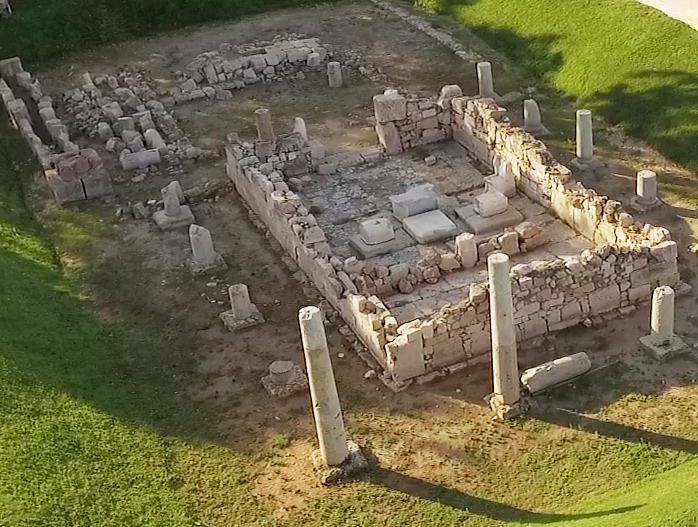
Ancient Temple of Apollon Zostiras
The temple of Apollo Zoster was discovered accidentally by children of the Vouliagmeni Orphanage, who, while playing on the beach near wall remains, found marble bases, column drums and part of an inscription, which mentioned the sanctuary of Apollo Zoster. Archaeological research began and during 1926-1927 the archaeologists K. Kourouniotes and M.Pittides brought the sanctuary to light.
The results of the excavation verified the ancient written sources (Strabo and Pausanias) and identified the area as the site where the Sanctuary of Apollo Zoster was located. More specifically, Pausanias refers to the existence of a temple dedicated to Apollo, Artemis and their mother Leto. He mentions that the name «Zoster» derives from a mythological tradition, according to which Leto, chased by the angry and deceived the wife of Zeus, Hera, stopped at this coast feeling that she was ready to deliver the twins gods Apollo and Artemis and thus loosened her girdle (zoster in Greek) so as to give birth. According to the excavator K. Kourouniotes, however, the correct name of the god is not Zoster but Zosterios, emphasizing the martial status of Apollo who is belted with his arms and is ready for war. Alternatively, the name of the temple devoted to the three gods could be also related to the geomorphology of the area, as it forms a narrow (girdle –“zoster”-like) strip of land.
The temple was built in the late 6th cent. B.C. (late archaic period) as the most important and it consists of the cult center of the ancient deme of Halai Aixonides in other words, the Saltfields of Aixōnē. Appart from Apollo, Artemis and Leto were also worshiped. It consists of a main cella (sekos), a peristasis (colonnade) and an altar
SEKOS The sekos measures 10,80 x 6,00 m. It preserves all four walls but only the north wall retains the archaic building system of polygonal masonry that belongs to the initial phase of construction. The rest of the walls preserve different systems of masonry, indicative of the long-term use of the temple. The archaic floor of the sekos is carefully paved with large slabs of titanium. The cross-wall that separates the cella in two parts is a later addition. Inside the sekos there are preserved:
A. Three marble bases, on which the cult statues of Apollo, Artemis and Leto were placed. Two of the bases preserve an inscription of the archaic period: ΗΑΛΑΙΕΙΣ ΑΝΕΘΕΣΑΝ (the people from Halai dedicated)
B. The marble throne of the priest
C. The marble altar, which bears an inscription referring to certain repairs of the temple in the 4th cent. B.C,. when Polystratus was the priest.
COLONNADE
The temple is surrounded by a colonnade with free standing columns, four at the front sides and six at the flanks. The columns rest on separate square plinths, which are not connected either between them or with the sekos walls.
ALTAR
In front of the temple’s entrance stands a large rectangular altar (4,25 x 2,55 m).
Because of the temple’s foundation on the sandy beach and the rise of the sea level, the temple was flooded until recently by groundwater, resulting in serious damage. The constant hard efforts of the Greek Archaeological Service for the rescue of the monument, coupled with the financial support of the “Astir Pallas” and the National Bank of Greece, resulted in the realization in 2011of an innovative drainage method, which assured the safety of the monument. The temple is located in the ASTIR PALACE Beach since 1960. Final restoration and conservation of the monument are imminent, as well as the construction of a new independent entrance for the transformation of the area into an organized archaeological site.
Reports
Herodotus, Histories
§8.107 for the king to pass over. And when the Barbarians were near Zoster as they sailed, then seeing the small points of rock which stretch
Xenophon, Hellenika
§5.1.9 when the ships of Eunomus were close to the shore near Cape Zoster in Attica, Gorgopas gave the order by the trumpet to sail against
Cicero, Letters
§52.201 Athens. On the 6th of July we got from the Piraeus to Zoster, with a troublesome wind, which kept us there on the 7th.
Strabo, Geography
§9.1.21 the aforesaid demes is a long cape, the first cape after Aexoneis, Zoster ; then another after Thoreis, I mean Astypalaea; off the former of
Stephanus of Byzantium, Ethnica
§Z298.1 Zoster: Ζωστήρ, τῆς Ἀττικῆς ἰσθμός, ὅπου φασὶ τὴν Λητὼ λῦσαι τὴν ζώνην [καὶ] §T611.3 γένεσιν οἱ μὲν ἐν Λυκίᾳ, οἱ δ΄ ἐν Δήλῳ, οἱ δ΄ ἐν Ζωστῆρι τῆς Ἀττικῆς, οἱ δὲ ἐν Τεγύρᾳ τῆς Βοιωτίας φασίν'. ὅθεν καὶ Τεγυρήιος
Pausanias, Description of Greece §1.31.1 At Alimus is a sanctuary of Demeter Thesmophoros and Kore, and at Zoster (Girdle) on the coast is an altar to Athena, as well as
Access instructions.
- Metro: Γ2, Line 2,(red), stop at: “Elliniko station” combine with Bus: • Line: 122 - Tram line, stop at “Voula station” combine with bus: • Bus: line117 - Bus: • Orange bus: Route: Athens - Sounion
Peculiarities - Danger
The temple can only be visited after consultation with the competent antiquities department. (email: This email address is being protected from spambots. You need JavaScript enabled to view it., Tel. 2104590700)